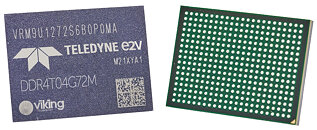Monday, May 25th 2020
Teledyne e2v Introduces First Radiation-Tolerant DDR4 Memory for Space Applications
Teledyne e2v has announced the DDR4T04G72M - the first radiation-tolerant DDR4 memory chip, featuring a total 4 GB capacity. Currently validated at 2133 MT/s, and targeting to offer 2400MT/s in the near future, this next-generation solution offers ultra-responsive low latency operation, while fitting into a highly compact form factor. Furthermore, high-reliability manufacturing and radiation-tolerant robustness makes it highly suitable for dealing with the rigors of space environments.
With 15 mm x 20 mm x 1.92 mm dimensions, this new space-grade device comprises an array of Micron based memory chips, integrated in a single package. It features a 72-bit bus, where 64 bits are dedicated to data and 8 bits to error correction code (ECC). Radiation tests have been performed on these memory chips and a single event effects (SEE) report is available from Teledyne e2v. In particular, the memory has been demonstrated to be single event latch-up (SEL) free up to 60+ MeV.cm²/mg.This new space-grade DDR4 memory enables elevated levels of performance, while taking up minimal board real estate - something that is certain to be of value in highly space-constrained, densely-packed satellite designs. It can be used in conjunction with processors and FPGAs having a DDR4 controller, and is in particular embedded on Teledyne e2v Space version of Qormino Common Compute Platform together with a space version of NXP LS1046 quad core processor (QLS1046-4 GB).
The thermally-enhanced packaging technology accelerates heat dissipation, in order to maintain continued operational reliability. Flight Models will be available up to an extended temperature range of -55°C to 125°C. It is compliant with NASA Level 1 (NASA EEE-INST-002 - Section M4 - PEMs) and ECSS Class 1 (ECSS-Q-ST-60-13C).
"The combination of radiation tolerance, rugged construction and small form factor, make this Radiation Tolerant 4 GB DDR4 memory a very appealing solution for integration into space-oriented systems," states Thomas Guillemain, Marketing & Business Development Manager at Teledyne e2V Semiconductors. "This space-grade DDR4 offers the transition path to newer generations of processing devices required by compute intensive space applications".
With 15 mm x 20 mm x 1.92 mm dimensions, this new space-grade device comprises an array of Micron based memory chips, integrated in a single package. It features a 72-bit bus, where 64 bits are dedicated to data and 8 bits to error correction code (ECC). Radiation tests have been performed on these memory chips and a single event effects (SEE) report is available from Teledyne e2v. In particular, the memory has been demonstrated to be single event latch-up (SEL) free up to 60+ MeV.cm²/mg.This new space-grade DDR4 memory enables elevated levels of performance, while taking up minimal board real estate - something that is certain to be of value in highly space-constrained, densely-packed satellite designs. It can be used in conjunction with processors and FPGAs having a DDR4 controller, and is in particular embedded on Teledyne e2v Space version of Qormino Common Compute Platform together with a space version of NXP LS1046 quad core processor (QLS1046-4 GB).
The thermally-enhanced packaging technology accelerates heat dissipation, in order to maintain continued operational reliability. Flight Models will be available up to an extended temperature range of -55°C to 125°C. It is compliant with NASA Level 1 (NASA EEE-INST-002 - Section M4 - PEMs) and ECSS Class 1 (ECSS-Q-ST-60-13C).
"The combination of radiation tolerance, rugged construction and small form factor, make this Radiation Tolerant 4 GB DDR4 memory a very appealing solution for integration into space-oriented systems," states Thomas Guillemain, Marketing & Business Development Manager at Teledyne e2V Semiconductors. "This space-grade DDR4 offers the transition path to newer generations of processing devices required by compute intensive space applications".

15 Comments on Teledyne e2v Introduces First Radiation-Tolerant DDR4 Memory for Space Applications
Other than that, I can only dream of using stuff like this. And that's probably a good thing.Only if they are using nuclear energy to glow... hey new product idea!
I was like oh so this is the beginning of skynet huh?
It wouldn't surprise me if the radiation is worse on Mars than in low orbit Earth. Most radiation is deflected by the magnetic field anyway and not the atmosphere which is a lot weaker on Mars.
There are lots of ices at the poles of Mars but the issue is as far as we know they aren't water ices (they are co2, aka dry ice).Go home Anakin.
The Earth has so many built in protections against natural things that would otherwise just outright kill us. We're shielded from radiation and harmful ultraviolet light, and more. If you're in space, it's open season for all that.
They where however engineer in such a way for full reliability in space, with all the radiation, cold and whatever more.
Still, I don't doubt the atmospheric and magnetic field protections are weaker in low earth orbit than normal, the question is how bad mars is in comparison and I'll be frank: I really have no idea.